#international and regional conventions
Explore tagged Tumblr posts
Text
الحماية القانونية للأشخاص من جريمة الاختفاء القسري في القانون الدولي
الحماية القانونية للأشخاص من جريمة الاختفاء القسري في القانون الدولي الحماية القانونية للأشخاص من جريمة الاختفاء القسري في القانون الدولي الكاتب : سي ناصر محمد . زازة لخضر الملخص: الاختفاء القسري ظاهرة قديمة عرفتها البشرية لوجود منطق القوة داخل المجتمعات، وجديدة في المجتمعات الحديثة في ظل الحروب والنزاعات المسلحة، ظاهرة مست الأمن والسلم ما نتج عنها من نزاعات وصراعات في الغالب تؤدي للحروب، ومست…
#and international law.#international and regional conventions#international mechanisms#Legal protection#the crime of enforced disappearance#الحماية القانونية ; الاتفاقيات الدولية والإقليمية ; جريمة الاختفاء القسري ; الآليات الدولية ; القانون الدولي
0 notes
Text
And why does America grow so much fucking corn? Well, several reasons, but dominant among them: Subsidised revenue insurance programs! "In 1949, government payments made up 1.4% of total net farm income — a measure of profit — while in 2000 government payments made up 45.8% of such profits. In 2019, farms received $22.6 billion in government payments, representing 20.4% of $111.1 billion in profits."

Bad year? Bad market? Get paid anyway. Grow corn! Why go to all the risk and expense of diversifying your operation to try and grow crops there's an actual market demand for when you could instead go all-in on corn and soybeans? Now so many farmers have gone down this route that if the government reduces those subsidies, it would devastate entire regions. In today's agricultural industry of broadacre cropping, most farming is done by massive, expensive, highly specialized machinery. You can't just pivot, because you're in debt on giant machines that really only work on corn. So the government isn't going to cut the subsidies. So more farmers are going to go all-in on the safe bet that is corn. It's a horrible self-perpetuating cycle.
(Source for quote and image: https://usafacts.org/articles/federal-farm-subsidies-what-data-says/)
I will write this thought about Veganism and Classism in the USA in another post so as to not derail the other thread:
There are comments in the notes that say meat is only cheaper than plant based foods because of subsidies artificially lowering the price of meat in the United States. This is...part of the story but not all of it.
For my animal agriculture lab we went to a butcher shop and watched the butcher cut up a pig into various cuts of meat. I have had to study quite a bit about the meat industry in that class. This has been the first time I fully realized how strongly the meat on a single animal is divided up by socioeconomic class.
Like yes, meat cumulatively takes more natural resources to create and thus should be more expensive, but once that animal is cut apart, it is divided up between rich and poor based on how good to eat the parts are. I was really shocked at watching this process and seeing just how clean and crisp an indicator of class this is.
Specifically, the types of meat I'm most familiar with are traditionally "waste" parts left over once the desirable parts are gone. For example, beef brisket is the dangly, floppy bit on the front of a cow's neck. Pork spareribs are the part of the ribcage that's barely got anything on it.
And that stuff is a tier above the "meat" that is most of what poor people eat: sausage, hot dogs, bologna, other heavily processed meat products that are essentially made up of all the scraps from the carcass that can't go into the "cuts" of meat. Where my mom comes from in North Carolina, you can buy "livermush" which is a processed meat product made up of a mixture of liver and a bunch of random body parts ground up and congealed together. There's also "head cheese" (made of parts of the pig's head) and pickled pigs' feet and chitlin's (that's made of intestines iirc) and cracklin's (basically crispy fried pig skin) and probably a bunch of stuff i'm forgetting. A lot of traditional Southern cooking uses basically scraps of animal ingredients to stretch across multiple meals, like putting pork fat in beans or saving bacon grease for gravy or the like.
So another dysfunctional thing about our food system, is that instead of people of each socioeconomic class eating a certain number of animals, every individual animal is basically divided up along class lines, with the poorest people eating the scraps no one else will eat (oftentimes heavily processed in a way that makes it incredibly unhealthy).
Even the 70% lean ground beef is made by injecting extra leftover fat back into the ground-up meat because the extra fat is undesirable on the "better" cuts. (Gross!)
I've made, or eaten, many a recipe where the only thing that makes it non-vegan is the chicken broth. Chicken broth, just leftover chicken bones and cartilage rendered and boiled down in water? How much is that "driving demand" for meat, when it's basically a byproduct?
That class really made me twist my brain around about the idea of abstaining from animal products as a way to deprive the industry of profits. Nobody eats "X number of cows, pigs, chickens in a lifetime" because depending on the socioeconomic class, they're eating different parts of the animal, splitting it with someone richer or poorer than they are. If a bunch of people who only ate processed meats anyway abstained, that wouldn't equal "saving" X number of animals, it would just mean the scraps and byproducts from a bunch of people's steaks or pork chops would have something different happen to them.
The other major relevant conclusion I got from that class, was that animal agriculture is so dominant because of monoculture. People think it's animal agriculture vs. plant agriculture (or plants used for human consumption vs. using them to feed livestock), but from capitalism's point of view, feeding animals corn is just another way to use corn to generate profits.
People think we could feed the world by using the grain fed to animals to feed humans, but...the grain fed to animals, is not actually a viable diet for the human population, because it's literally just corn and soybean. Like animal agriculture is used to give some semblance of variety to the consumer's diet in a system that is almost totally dominated by like 3 monocrops.
Do y'all have any idea how much of the American diet is just corn?!?! Corn starch, corn syrup, corn this, corn that, processed into the appearance of variety. And chickens and pigs are just another way to process corn. That's basically why we have them, because they can eat our corn. It's a total disaster.
And it's even worse because almost all the USA's plant foods that aren't the giant industrial monocrops maintained by pesticides and machines, are harvested and cared for by undocumented migrant workers that get abused and mistreated and can't say anything because their boss will tattle on them to ICE.
#agriculture#monoculture#economics#Many countries have problems with lack of agricultural diversity due to government subsidy programs gone wrong#but America's pretty special#in Arizona specifically they grow a crazy amount of cotton#it's a desert#Cotton needs a ton of water#but due to circumstances based in the fucking CIVIL WAR#the self-perpetuating cycle of growing cotton for subsidies is so deeply entrenched in the region's economy that nobody's game to change it#so they're just draining the Colorado river to water cotton plants#like America's cotton and sugar subsidies are so extreme that they actually violate some international trade conventions#they almost got in trouble for it but they made some sneaky deals with the countries objecting and now those countries#also get to do illegal subsidies without getting in trouble#yay#problem solved#sigh
8K notes
·
View notes
Text
Preserving the markhor and its natural habitat is an ecological imperative.
May 24, 2024 marks 1st-ever International Day of the Markhor. Preserving the markhor and its natural habitat is an ecological imperative. It was categorized as “near threatened” in 2014 and is on IUCNRedList , and has been included in Appendix I to CITES since 1992.
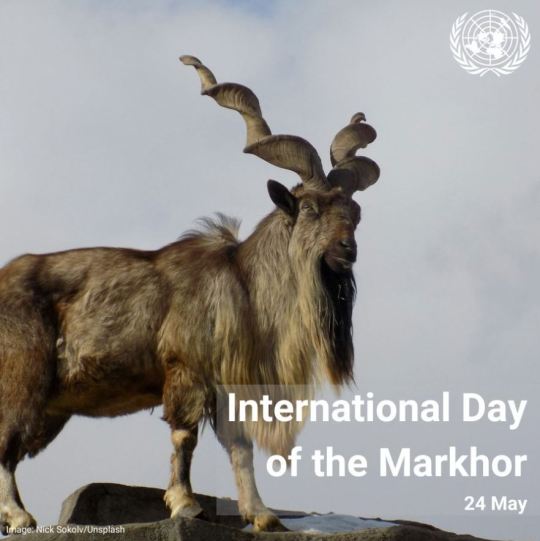
#CITES#convention on international trade in endangered species of wild fauna and flora#near threatened#natural habitat#straight horned markhor#bukharan markhor#markhor conservation#markhor#24 may#regional strategy#iucn#appendix I
0 notes
Text
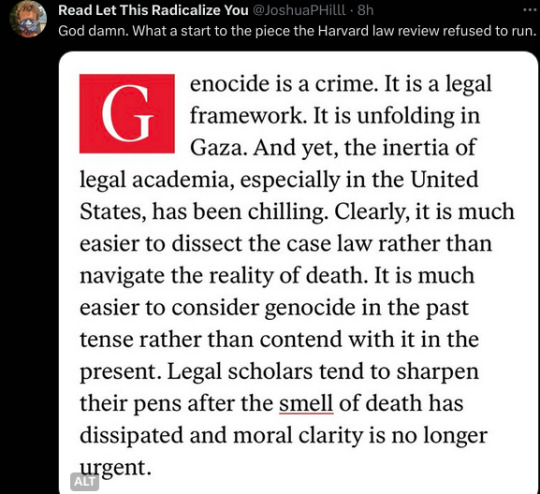
In a statement that was shared with The Nation, a group of 25 HLR editors expressed their concerns about the decision. “At a time when the Law Review was facing a public intimidation and harassment campaign, the journal’s leadership intervened to stop publication,” they wrote. “The body of editors—none of whom are Palestinian—voted to sustain that decision. We are unaware of any other solicited piece that has been revoked by the Law Review in this way. “ When asked for comment, the leadership of the Harvard Law Review referred The Nation to a message posted on the journal’s website. “Like every academic journal, the Harvard Law Review has rigorous editorial processes governing how it solicits, evaluates, and determines when and whether to publish a piece…” the note began. ”Last week, the full body met and deliberated over whether to publish a particular Blog piece that had been solicited by two editors. A substantial majority voted not to proceed with publication.” Today, The Nation is sharing the piece that the Harvard Law Review refused to run. Some may claim that the invocation of genocide, especially in Gaza, is fraught. But does one have to wait for a genocide to be successfully completed to name it? This logic contributes to the politics of denial. When it comes to Gaza, there is a sense of moral hypocrisy that undergirds Western epistemological approaches, one which mutes the ability to name the violence inflicted upon Palestinians. But naming injustice is crucial to claiming justice. If the international community takes its crimes seriously, then the discussion about the unfolding genocide in Gaza is not a matter of mere semantics. The UN Genocide Convention defines the crime of genocide as certain acts “committed with the intent to destroy, in whole or in part, a national, ethnical, racial or religious group, as such.” These acts include “killing members of a protected group” or “causing serious bodily or mental harm” or “deliberately inflicting on the group conditions of life calculated to bring about its physical destruction in whole or in part.” Numerous statements made by top Israeli politicians affirm their intentions. There is a forming consensus among leading scholars in the field of genocide studies that “these statements could easily be construed as indicating a genocidal intent,” as Omer Bartov, an authority in the field, writes. More importantly, genocide is the material reality of Palestinians in Gaza: an entrapped, displaced, starved, water-deprived population of 2.3 million facing massive bombardments and a carnage in one of the most densely populated areas in the world. Over 11,000 people have already been killed. That is one person out of every 200 people in Gaza. Tens of thousands are injured, and over 45% of homes in Gaza have been destroyed. The United Nations Secretary General said that Gaza is becoming a “graveyard for children,” but a cessation of the carnage—a ceasefire—remains elusive. Israel continues to blatantly violate international law: dropping white phosphorus from the sky, dispersing death in all directions, shedding blood, shelling neighborhoods, striking schools, hospitals, and universities, bombing churches and mosques, wiping out families, and ethnically cleansing an entire region in both callous and systemic manner. What do you call this? The Center for Constitutional Rights issued a thorough, 44-page, factual and legal analysis, asserting that “there is a plausible and credible case that Israel is committing genocide against the Palestinian population in Gaza.” Raz Segal, a historian of the Holocaust and genocide studies, calls the situation in Gaza “a textbook case of Genocide unfolding in front of our eyes.”
#palestine#gaza#free palestine#end the the colonialism#end the occupation#harvard#harvard law review#genocide
7K notes
·
View notes
Text
(8th meeting) Open-ended working group on conventional ammunition - Fourth substantive session.
Statements by international and regional organizations, followed by non-governmental organizations and civil society (informal meeting) 5. Elaboration of a new global framework that will address existing gaps in through-life ammunition management: (continued) (f) Elaboration of a set of political commitments as a new global framework that will address existing gaps in through-life ammunition management, including international cooperation and assistance
8th meeting of the Open-ended working group on conventional ammunition - Fourth substantive session.
#conventional arms#disarmament#Ammunition#Open-ended working group on Conventional arms#plenary session#international cooperation#international assistance#political commitments#regional organizations#International organizations
0 notes
Text
Naming International POC Characters: Do Your Research.
This post is part of a double feature for the same ask. First check out Mod Colette's answer to OP's original question at: A Careful Balance: Portraying a Black Character's Relationship with their Hair. Below are notes on character naming from Mod Rina.
~ ~ ~
@writingraccoon said:
My character is black in a dungeons and dragons-like fantasy world. His name is Kazuki Haile (pronounced hay-lee), and his mother is this world's equivalent of Japanese, which is where his first name is from, while his father is this world's equivalent of Ethiopian, which is where his last name is from. He looks much more like his father, and has hair type 4a. [...]
Hold on a sec.
Haile (pronounced hay-lee), [...] [H]is father is this world’s equivalent of Ethiopian, which is where his last name is from.
OP, where did you get this name? Behindthename.com, perhaps?

Note how it says, “Submitted names are contributed by users of this website. Check marks indicate the level to which a name has been verified.” Do you see any check marks, OP?
What language is this, by the way? If we only count official languages, Ethiopia has 5: Afar, Amharic, Oromo, Somali, & Tigrinya. If we count everything native to that region? Over 90 languages. And I haven't even mentioned the dormant/extinct ones. Do you know which language this name comes from? Have you determined Kazuki’s father’s ethnic group, religion, and language(s)? Do you know just how ethnically diverse Ethiopia is?
~ ~ ~
To All Looking for Character Names on the Internet:
Skip the name aggregators and baby name lists. They often do not cite their sources, even if they’re pulling from credible ones, and often copy each other.
If you still wish to use a name website, find a second source that isn’t a name website.
Find at least one real life individual, living or dead, who has this given name or surname. Try Wikipedia’s lists of notable individuals under "List of [ethnicity] people." You can even try searching Facebook! Pay attention to when these people were born for chronological accuracy/believability.
Make sure you know the language the name comes from, and the ethnicity/culture/religion it’s associated with.
Make sure you understand the naming practices of that culture—how many names, where they come from, name order, and other conventions.
Make sure you have the correct pronunciation of the name. Don’t always trust Wikipedia or American pronunciation guides on Youtube. Try to find a native speaker or language lesson source, or review the phonology & orthography and parse out the string one phoneme at a time.
Suggestions for web sources:
Wikipedia! Look for: “List of [language] [masculine/feminine] given names,” “List of most common [language] family names,” “List of most common surnames in [continent],” and "List of [ethnicity] people."
Census data! Harder to find due to language barriers & what governments make public, but these can really nail period accuracy. This may sound obvious, but look at the year of the character's birth, not the year your story takes place.
Forums and Reddit. No really. Multicultural couples and expats will often ask around for what to name their children. There’s also r/namenerds, where so many folks have shared names in their language that they now have “International Name Threads.” These are all great first-hand sources for name connotations—what’s trendy vs. old-fashioned, preppy vs. nerdy, or classic vs. overused vs. obscure.
~ ~ ~
Luckily for OP, I got very curious and did some research. More on Ethiopian & Eritrean naming, plus mixed/intercultural naming and my recommendations for this character, under the cut. It's really interesting, I promise!
Ethiopian and Eritrean Naming Practices
Haile (IPA: /həjlə/ roughly “hy-luh.” Both a & e are /ə/, a central “uh” sound) is a phrase meaning “power of” in Ge’ez, sometimes known as Classical Ethiopic, which is an extinct/dormant Semitic language that is now used as a liturgical language in Ethiopian churches (think of how Latin & Sanskrit are used today). So it's a religious name, and was likely popularized by the regnal name of the last emperor of Ethiopia, Haile Selassie (“Power of the Trinity”). Ironically, for these reasons it is about as nationalistically “Ethiopian” as a name can get.
Haile is one of the most common “surnames” ever in Ethiopia and Eritrea. Why was that in quotes? Because Ethiopians and Eritreans don’t have surnames. Historically, when they needed to distinguish themselves from others with the same given name, they affixed their father’s given name, and then sometimes their grandfather’s. In modern Ethiopia and Eritrea, their given name is followed by a parent’s (usually father’s) name. First-generation diaspora abroad may solidify this name into a legal “surname” which is then consistently passed down to subsequent generations.
Intercultural Marriages and Naming
This means that Kazuki’s parents will have to figure out if there will be a “surname” going forward, and who it applies to. Your easiest and most likely option is that Kazuki’s dad would have chosen to make his second name (Kazuki’s grandpa’s name) the legal “surname.” The mom would have taken this name upon marriage, and Kazuki would inherit it also. Either moving abroad or the circumstances of the intercultural marriage would have motivated this. Thus “Haile” would be grandpa’s name, and Kazuki wouldn’t be taking his “surname” from his dad. This prevents the mom & Kazuki from having different “surnames.” But you will have to understand and explain where the names came from and the decisions dad made to get there. Otherwise, this will ring culturally hollow and indicate a lack of research.
Typically intercultural parents try to
come up with a first name that is pronounceable in both languages,
go with a name that is the dominant language of where they live, or
compromise and pick one parent’s language, depending on the circumstances.
Option 1 and possibly 3 requires figuring out which language is the father’s first language. Unfortunately, because of the aforementioned national ubiquity of Haile, you will have to start from scratch here and figure out his ethnic group, religion (most are Ethiopian Orthodox and some Sunni Muslim), and language(s).
But then again, writing these characters knowledgeably and respectfully also requires figuring out that information anyway.
~ ~ ~
Names and naming practices are so, so diverse. Do research into the culture and language before picking a name, and never go with only one source.
~ Mod Rina
#asks#language#languages#linguistics#east africa#african#immigration#ethiopian#names#naming#research#resources#writeblr#character names#character name ideas#rina says read under the cut. read it
4K notes
·
View notes
Text
"The Seychelles has become a major tourist destination for beachgoing and scuba diving, but it’s not only humans that are beginning to flock to this island.
In what marine biologists have described as a “phenomenal finding,” a survey of whales around the territorial waters of this archipelagic nation revealed the presence of blue whales—over a dozen.
It’s the first time they’ve been seen in these warm seas since 1966, and it’s a wonderful milestone in a long and increasingly successful recovery for the world’s largest animal.
The Seychelles are located in the Indian Ocean off the east coast of Africa, and they were historically a stopover point for Soviet whalers en route to Antarctica. The years 1963 to 1966 were particularly difficult for whales here, and many were taken before the International Convention on the Regulation of Whaling put an end to the practice of hunting baleen whales in 1973.
Since 1966, no dedicated investigation of whales in the Seychelles had been made until 2020, when a partnership of four universities conducted an acoustic survey over the period of two years.
They made five different sightings of groups of up to 10 animals.
“This was a phenomenal finding,” Jeremy Kiszka, a co-author of the paper from Florida International University, wrote in The Conversation. “We were prepared to not see any blue whales due to the high level of hunting that occurred fairly recently and absolutely no information was available since the last blue whale was killed in the region in 1964.” ...
The team behind the survey sent images taken of the whales’ dorsal sides to a database to see if any of them had been recorded before, and amid the reel, not a single one was a match with any other photographed whale.
This, the team suggests, means they have probably never been seen before, which for a species that big might seem strange, but along with there being only 5,000 to 15,000 on Earth, they migrate vast distances while diving deep, making recording their movements incredibly challenging.
The survey identified 23 whale species in total using hydroponic mics over 2 years with peak activity coming between December and April. This is a fascinating finding that suggests something about the seas around the Seychelles makes for excellent whale habitat."
-via Good News Network, April 30, 2024
#whales#blue whales#animals#marine life#marine biology#sea creatures#cetacean#seychelles#indian ocean#conservation#endangered species#whaling#conservation news#climate hope#good news#hope
962 notes
·
View notes
Text
In the weeks since Hamas' Oct. 7 attack, Israeli airstrikes on the Gaza Strip have killed more than 15,000 Palestinians, according to Gaza's health ministry, and destroyed thousands of homes in the territory.
And there have also been tremendous losses to the region's ancient and globally significant cultural heritage. The region was a hub for commerce and culture under Egyptian, Greek, Roman and Byzantine rule. It remained influential for centuries thereafter.
A recent survey by the group Heritage for Peace details the damage done so far to more than 100 of these landmarks in Gaza since the start of the present conflict.
The casualties include the Great Omari Mosque, one of the most important and ancient mosques in historical Palestine; the Church of Saint Porphyrius, thought to be the third oldest church in the entire world; a 2,000-year-old Roman cemetery in northern Gaza excavated only last year; and the Rafah Museum, a space in southern Gaza which was dedicated to teaching about the territory's long and multi-layered heritage — until it was hammered by airstrikes early on in the conflict. (...)
"If this heritage be no more in Gaza, it will be a big loss of the identity of the people in Gaza," said Isber Sabrine, president of Heritage for Peace, in an interview with NPR. (...)
"The people in Gaza, they have the right to keep and to save this heritage, to tell the history, the importance of this land," he said.
The 1954 Hague Convention, agreed to by Palestinians and Israelis, is supposed to safeguard landmarks from the ravages of war. But landmarks in Gaza have been destroyed by Israeli strikes in earlier rounds of fighting. Dozens of sites, including the now-obliterated Great Omari Mosque, suffered damage in 2014. A report by UNESCO, the United Nations body that designates and protects World Heritage sites, cites further destruction to cultural and historic sites in Gaza in 2021. (...)
Destruction of historical sites and other cultural sites is part of genocide, it's the destruction of the proof of a people's relationship to the land and a horrible emotional blow at the community. UNESCO must act immediately against Israel's destruction of Palestinian heritage, and every country and international organism must expel Israel and impose sanctions to make the genocide and apartheid end.
#💬#palestine#gaza#israel#free palestine#world heritage#cultural heritage#historical sites#archaeology#cultures
2K notes
·
View notes
Text
Biden proposes South Carolina as first primary state in drastic shake up of presidential nominating calendar | CNN Politics
Biden proposes South Carolina as first primary state in drastic shake up of presidential nominating calendar | CNN Politics
CNN — President Joe Biden has asked Democratic National Committee leaders to drastically reshape the 2024 presidential nominating calendar and make South Carolina the first state to host a primary, followed by Nevada and New Hampshire on the same day a week later, Georgia the following week and then Michigan, a source confirms to CNN. Biden’s preferences were announced Thursday evening at a…
View On WordPress
#continents and regions#democratic national convention#domestic alerts#domestic-us politics#elections (by type)#elections and campaigns#government and public administration#iab-elections#iab-politics#international alerts#international-us politics#Iowa#joe biden#Michigan#midwestern united states#Minnesota#Nevada#New Hampshire#new hampshire primary#north america#northeastern united states#political candidates#political events#political figures - us#political organizations#political party conventions#Politics#primaries and caucuses#south carolina#south carolina primary
0 notes
Text
Currently losing my mind a little bit trying to find an alternate name for the Recursive Transform Array/Abstract Convergence Manifold regions in Five Pebbles/Looks to the Moon respectively. I think both names mean roughly the same thing.


(Left: Coils in the Recursive Transform Array, Right: Coils in the Abstract Convergence Manifold)
(Theorizing under the cut)
Both regions contain sets of large transformers (or inductors, they both look like coils) arranged into different groups. I assume the function of this region is to receive power from an iterator's power source (how iterators get their power isn't exactly clear- but at least in Pebbles' case it probably comes from the Linear Systems Rail) and step up or down the voltage so it can be distributed to the different electronic components of an iterator's superstructure as needed.
Stepping up/down voltage is the function of a transformer, which is where I assume the "transform" part of "Recursive Transform Array" comes from. In Moon's case, "abstract" in "Abstract Convergence Manifold" is a synonym for "transform" or "change", one thing is being abstracted, or changed into something else.
"Recursive" means "repeating" (and "repeat" is a synonym of "iterate", funnily enough), so this part probably refers to the multiple similar transformers found in the Recursive Transform Array.
In terms of the Abstract Convergence Manifold, either "convergence" or "manifold" could correspond to the "multiple similar things" meaning. The objects in question are "converging", coming together, or being similar.
"Manifold" is a bit trickier, the general definition means "variety" or "many", but the word has other uses. In typography, it can refer to the process of making copies of a document (via a carbon copy), and in engineering it can refer to a component that distributes gas or liquid to different parts of a system. So in this case, I'm going to assume that "manifold" means "copies" and/or "distribution". This makes sense if the Abstract Convergence Manifold distributes power (or maybe even Void Fluid) to different parts of Moon's structure.
And finally, "array" in "Recursive Transform Array" means a group of things arranged in a pattern. This is also probably what "manifold" in "Abstract Convergence Manifold" means; a group of copies of things.
Based on this, both names basically mean "group of similar/repeating things that change". This might not just refer to the groups of transformer coils, but also to the big square structures that both Pebbles and Moon have in these regions:

(These rooms are very dark, I'm only showing Pebbles' here because it's better lit than Moon's.)
This thing looks like a big computer chip, maybe a Central Processing Unit (CPU). I theorize that this room is where the majority of an iterator's processing takes place; where the actual iteration (in terms of computing: repeating a process) happens. So the things that are repeating and changed could be the actual iterative processes (simulations, thoughts, calculations) are carried out, altered slightly, and repeated again.
(Side tangent: I've always wondered what Pebbles was referring to when he mentioned his "processing strata". It might be layers of processors located in his Recursive Transform Array, possibly in the same big room as the square thing. Personally I think the processing strata are the little blinking lights you can see in the background of this room, but I could be wrong. If anyone actually knows the answer please let me know.)
TL,DR: If you have an iterator OC and you want to give their internal regions names but you don't want to simply copy existing ones, I'm pretty sure the naming convention for the transformer arrays uses synonyms for (similar/repeating) (change) (group). For example, "Sequential Flux Assemblage", "Parallel Modification Cluster". These sound silly, but basically everything iterator-related is silly technobabble, so I think the moral is to have fun with it.
Thank you for reading, and let me know if you have any ideas. I enjoy talking to people about random Rain World theories.
#this is another theory spiral I fell down while trying to flesh out OC lore. enjoy#rain world#iterators#rain world iterator#rw iterator#personal#rain world theory#delta's lore corner
344 notes
·
View notes
Text

So you want to preorder the NEW Batgirl #1 coming to a comic shop near you on November 6?
Well, hopefully, this can help you attain that preorder. So you're doing your part to make sure this series lasts.
The first step is to find your local comic shop. Use a search engine for that most heavenly of place that has comics.
Or if you already know search them online (they might have an online shop), an app, call the store, or visit it in person.
Now I'm using my experience from the shops I visit in the midwestern area. So this could be different in the region you're in the US (or Canada). I have no idea on the best way to attain this book outside the country save Canada. So anyone who can answer that pls chim in here.
I mean, possibly, you could buy it on their website (or their eBay shop) and MAYBE they have international shipping. Then again, if you have a US friend maybe they can do this all for you?
Preorders will begin next month. If you go in person you could put your order in. If you know those who work at the LCS they might think of you and put that in your pull list.
I know one LCS in my area, he is thoughtful enough to sometimes keep a variant that has Cass for me knowing that Wed I pull up I'll nab it. Cause he knows my weakness. That, and Rian Gonzales variants.
Likewise, the other LCS I went too. There was a clerk there who'd put stuff in my pull that she knew I'd like.
But there's always that chance they might not do any of this. So it's best to just do this person next month to guarantee your preorder.

Now let's talk about variants. Some shops if they sense there's "blood in the water" when preordering will order more comics. More comics mean more chances to get the variants (i.e. the Artgerm or Jeff Dekal ones).
There are only two variants that might be problematic to attain that I can foresee.
The holo variant from Artgerm one. Unless there's a comic convention near you that same weekend there's a good chance these might sell pretty fast. It is Artgerm after all.
Unless, your LCS is part of a "larger" chain. So one of my LCSs is a Graham Crackers which is a HUGE midwestern comic shop. So there's a really good chance I'll be able to attain all my variants.
HOWEVER....
The other LCS I go to, while they are my primary pull list really don't dabble much too much in variant covers.
This is because they're trying to make a profit and they don't see being able to make one. At least that's what I was told back when I had Batgirls on my pull.
If they do. It would be two or three copies. Like the last AAPI Batgirls variant. Said my shop owner did secure me a copy even without me asking them because they knew of my interest in Cass.
I've noticed since they "enacted" that policy they do order more of the "hotter" comics. Like I noticed a few Birds of Prey, Batman, and X-Men variants in one visit not too long ago.
Still, I know attaining the 1:25 Skylar Patridge will be next to impossible from them. They don't order 25 copies of a comic (unless it's Batman or Spider-Man).

For that, I'd recommend a larger comic shop chain (or if you know your LCS. They might order enough and you can reserve said copy via them next month).
If not...
Again, I'd recommend a larger chain with their web shop or if they have one via eBay. I've nabbed all the variants I want because Graham Crackers is HUGE in the Midwest.
If you know your shop will have more than 25 copies of Batgirl #1 please preorder the 1:25 by Patridge next month if possible.
Or wait until their website opens orders (usually a week prior to release on a Thursday.
If not... There's always a chance if there's a comic around that period (or a bit after) they might have it to purchase. However, you so won't be paying the original cost of it. 😬
Now here's my overall impression of the release. DC itself doesn't think this comic might sell. I mean they're only doing a 1:25 only for this series. That's it.
That already is 🚨 because we aren't getting a 1:50 like we did with Batgirls #1.

That is why I HIGHLY stress PLEASE PREORDER THIS COMIC! DO NOT WAIT UNTIL NOVEMBER 6th! Show your love for this character by preordering the heck out of it! Add this to your pull list!
Please do your part!
That said, please go crazy and nab these covers and variants. They ain't kidding when the last Cass solo was over 14 years ago (I'm counting Batgirl Vo1. 2). You've voiced your want. DC heard it. This is you honoring that want.
Cause if not...
Well, I can't say cause in all honesty? The old DC regime is gone. They ain't side scheming or pushing something else behind the scenes. Just this might be it for Cass when it comes to an ongoing solo.
Why I say please do your part. Hopefully, this helps and if not someone better than me can advise you better (and they reply via this post). But this is me doing my best with the knowledge I know.
128 notes
·
View notes
Text
Resolution adopted by the General Assembly on 2 May 2024.

The General Assembly, Reaffirming its resolution 70/1 of 25 September 2015, entitled “Transforming our world: the 2030 Agenda for Sustainable Development”, by which it adopted a comprehensive, far-reaching and people-centred set of universal and transformative Sustainable Development Goals and targets, Reaffirming also its resolutions 53/199 of 15 December 1998 and 61/185 of 20 December 2006 on the proclamation of international years, and Economic and Social Council resolution 1980/67 of 25 July 1980 on international years and anniversaries, in particular paragraphs 1 to 10 of the annex thereto on the agreed criteria for the proclamation of international years, as well as paragraphs 13 and 14, in which it is stated that an international day or year should not be proclaimed before the basic arrangements for its organization and financing have been made, Reaffirming further the intrinsic value of wildlife and its various contributions, including its ecological, genetic, social, economic, scientific, educational, cultural, recreational and aesthetic contributions to sustainable development and human wellbeing, and recognizing that wild fauna in their many beautiful and varied forms are an irreplaceable part of the natural systems of the Earth which must be protected for this generation and the generations to come, Stressing the urgent need to address the unprecedented global decline in biodiversity, including by preventing the extinction of threatened species, improving and sustaining their conservation status and restoring and safeguarding ecosystems that provide essential functions and services, including services related to water, health, livelihoods and well-being,
Underlining that the markhor (Capra falconeri) is an iconic and ecologically significant species found across the mountainous regions of Central and South Asia, including Afghanistan, India, Pakistan, Tajikistan, Turkmenistan and Uzbekistan, and recognizing that the markhor was categorized as “near threatened” in 2014 and is on the International Union for Conservation of Nature Red List of Threatened Species, and has been included in appendix I to the Convention on International Trade in Endangered Species of Wild Fauna and Flora since 1992, Recognizing that preserving the markhor and its natural habitat is an ecological imperative and a significant opportunity to bolster the regional economy, foster conservation efforts and promote sustainable tourism and economic growth and that conservation efforts will benefit the ecosystem, Stressing that, besides its ecological value, the markhor is a valuable species that contributes to the local economy and conservation initiatives, Recognizing national and regional initiatives for range State cooperation, transboundary approaches and mechanisms at the regional level to foster conservation of the markhor,
Noting the upcoming Ninth World Conference on Mountain Ungulates, to be held in Dushanbe from 12 to 15 October 2024, Recognizing that the greatest threats to the survival of the markhor are habitat loss, illegal hunting, including poaching, and climate change, Recalling its resolution 78/155 of 19 December 2023, entitled “Implementation of the Convention on Biological Diversity and its contribution to sustainable development”, in which it called upon parties to the Convention and stakeholders to strengthen international cooperation measures for the fulfillment of obligations contained in the Convention, Recognizing efforts for the conservation of the markhor, including the establishment of breeding programmes and the development of a regional strategy and national action plans for the conservation of the markhor in some range States that aim to protect the species throughout its range,
Decides to proclaim 24 May the International Day of the Markhor;
Invites all Member States, organizations of the United Nations system, other international and regional organizations, civil society, non-governmental organizations, individuals and other relevant stakeholders to observe the International Day of the Markhor, as appropriate;
Invites all relevant stakeholders to give due consideration to enhancing international and regional cooperation in support of efforts to conserve the markhor, given its role in the overall ecosystem;
Invites the United Nations Environment Programme to facilitate the observance of the International Day of the Markhor, mindful of the provisions contained in the annex to Economic and Social Council resolution 1980/67;
Stresses that the cost of all activities that may arise from the implementation of the present resolution should be met from voluntary contributions and that such activities would be subject to the availability and provision of voluntary contributions;
Requests the Secretary-General to bring the present resolution to the attention of all Member States, the organizations of the United Nations system and civil society organizations for appropriate observance.
United Nations General Assembly Resolution 78/278 - International Day of the Markhor.
Seventy-eighth session Agenda item 13: Integrated and coordinated implementation of and follow-up to the outcomes of the major United Nations conferences and summits in the economic, social and related fields.
77th plenary meeting - 2 May 2024.
#civil society organizations#member states#united nations general assembly#united nations economic and social council#united nations secretary general#International Day of the Markhor#24 May#United Nations Environment Programme#regional strategy#markhor conservation#resolutions#Resolution 78/278#protect the species#breeding programmes#habitat loss#illegal hunting#near threatened#conservation efforts#sustainable tourism#Convention on Biological Diversity#national and regional initiatives#international and regional organizations#civil society#non-governmental organizations#individuals
0 notes
Note
My favorite thing about the whole international Miku thing people are doing is the implication that regional Mikus are a thing and they probably host annual conventions like mall Santas.
I'm reminded of Batmen of All Nations

88 notes
·
View notes
Text
Excerpt from this story from Inside Climate News:
With the Earth at its most degraded point in recorded history, and humans making insufficient efforts to prevent the destruction of ecosystems, a growing number of scientists, lawyers and activists are proposing a potential solution that challenges more than 350 years of global governance.
The idea is to get countries and civil society to sign onto a declaration that recognizes Antarctica and its surrounding Southern Ocean as its own autonomous legal entity, similar to a sovereign country. Along with that status comes the right of Antarctica to participate in decision making that affects it, like the United Nations conferences on climate and biodiversity.
On Thursday, advocates with the group Antarctic Rights unveiled a draft declaration that would do just that. The document also says the continent possesses inherent rights to exist and continue its natural cycles “free of human disruptions.” Thursday’s event took place on the sidelines of the 16th gathering of parties to the U.N. Convention of Biological Diversity being held in Colombia.
Since 1959 the region has been governed by the Antarctic Treaty System, a Cold War-era pact designed to promote peace and scientific cooperation south of 60 degrees latitude. While largely successful at achieving those goals, that system has been criticized for making little progress on issues like environmental protection in recent years. Political deadlock, for instance, has prevented the creation of new Marine Protected Areas and the implementation of existing ones in the region.
Antarctic Rights’ proposal is part of the growing rights of nature movement, which has cemented various rights of ecosystems and individual species, like sea turtles, into legislation and court rulings in more than a dozen countries. The worsening climate and biodiversity crises have helped the movement gain momentum. In Ecuador, frogs have taken mining companies to court and won. In Colombia, courts have appointed human-guardians to oversee the rights of the Atrato River. There’s even precedent for giving nature a seat in the boardrooms of companies.
But never has an idea been set forth to put a natural entity on par with nation-states. Since the 1600s, international law has treated national governments as the primary force in global decision making.
Critics of that structure, which political scientists call the Westphalian system, argue that it is ill-equipped to handle many of today’s problems, including climate change and environmental destruction, which span national borders. Advocates argue that the nation-state system has an inherent and narrow focus on short-term human interests, neglecting other forms of life.
55 notes
·
View notes
Text
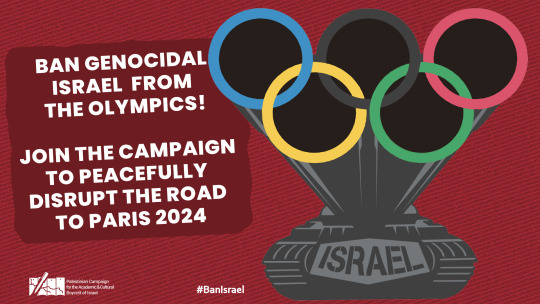
More than 300 Palestinian sports teams are calling to ban Israel from the Olympics over its genocide against Palestinians in Gaza.
The Israeli offensive on Gaza has claimed the lives of 26,706 civilians, including 11,422 infants and children. Ninety percent of Palestinians are internally displaced and living in inhumane conditions with “no electricity, no food, no water, no fuel.” No functional hospitals. No mosques. No churches. No libraries. No schools. No universities. No bakeries. At this rate, the brutal Israeli regime will soon destroy every aspect of life in Gaza, including its sports.
Join the global campaign to peacefully disrupt the road to Paris 2024 calling on the IOC to #BanIsrael until it ends its crimes against Palestinians and recognizes our UN-stipulated rights.
Register your group to join the campaign
We thus urgently demand:
An immediate suspension of Israel from participation in all international sports until it fully complies with international law and sports regulations
For global and European sports governing bodies to immediately uphold their statutory obligations – especially their own rules on human rights and non-discrimination given Russian, South African and other precedents. This would include, inter alia, a ban on Israel competing at the 2024 Paris Olympics, FIFA World Cup, and UEFA’s EURO.
For a deeper analysis on the rationale to suspend Israel from international sports, please review this paper (also available in Spanish) that will be sent to sports organisations.

Here’s what you can do.
1. Join the Global Day(s) of Action, March 15-17
Ahead of the IOC executive board meeting in Lausanne Switzerland (March 19-21), take the call from Palestinian teams to your National Olympic Committee, International Sports Federations and Recognized Sports Federations. Organize protests, sit-ins, peaceful disruptions, or awareness raising events on Israeli attacks on Palestinian sports. Register your group for more information.
2. Olympics qualifiers and events
From now until the Olympic Games start in July, the road to Paris will be filled with opportunities to remind the IOC that there is no place in the Olympics for genocide perpetrators. Earlier this month, four runners took the #CeasefireNow message to the Olympic Trials Marathon in Florida, crossing the finish line with Palestinian flags. Find information on Olympic time trials and qualifiers (also here) or other Olympics-related events in your area. Register your group for more information.
3. Kick Israeli apartheid out of sports
Is your country a signatory to the International Convention Against Apartheid in Sports? If so, it has an obligation to “take all appropriate action to secure the expulsion of a country practising apartheid from international and regional sports bodies.” Register your group to learn what you can do.
4. Sign the petition to ban Israel from world sports
Join more than 70,000 people from all over the world who have signed the petition calling for banning Israel from international sport.
Add your signature here
Israel has killed Palestinian Olympic Football coach Hani Al Masdar, destroyed the Palestinian Olympic Committee offices, and turned sports facilities into shameful mass detention and torture centers.
We can’t sit back as the IOC allows Israel to use the Olympics to sportswash its genocide in Gaza and its apartheid regime against Palestinians everywhere. Support the call from Palestinian teams.
Join the campaign to #BanIsrael from the Olympics and peacefully disrupt the road to the Paris 2024 games.
#israel#free gaza#gaza strip#israel is a terrorist state#gazaunderattack#genocide#gaza#free palestine#palestine#jerusalem#news#palestine news#war on gaza#news update#palestinian resistance#war news#northern gaza#west bank#rafah#tel aviv#strike#global strike#strike for palestine#strike for gaza#protest#boycotts#olympics#ban israel#free plaestine#free yemen
247 notes
·
View notes
Text
Brandt's Bat: researchers once documented a case in which a Brandt's bat had survived in the wild for more than 40 years, making this the longest-living bat species in the world
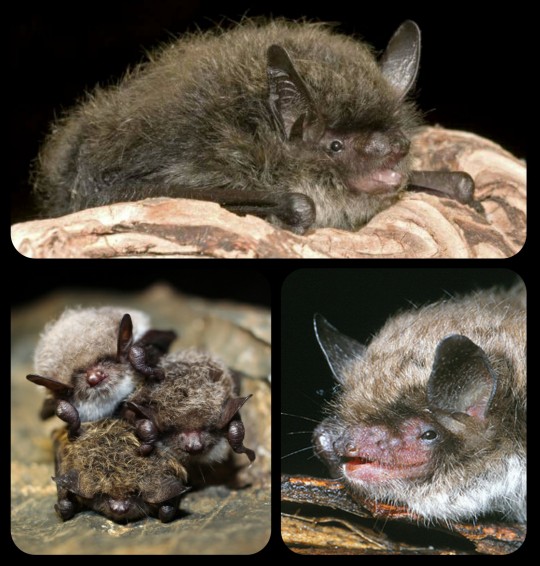
In 1964, a wild Brandt's bat (Myotis brandtii) was captured, banded, and released by researchers in the Biryusa region of Siberia. The very same bat was eventually recaptured by another team of researchers in 2005; it would have been at least 41 years old by then, making it the oldest bat ever recorded.
The previous record-holder was also a Siberian Brandt's bat (with an estimated age of 38 years).
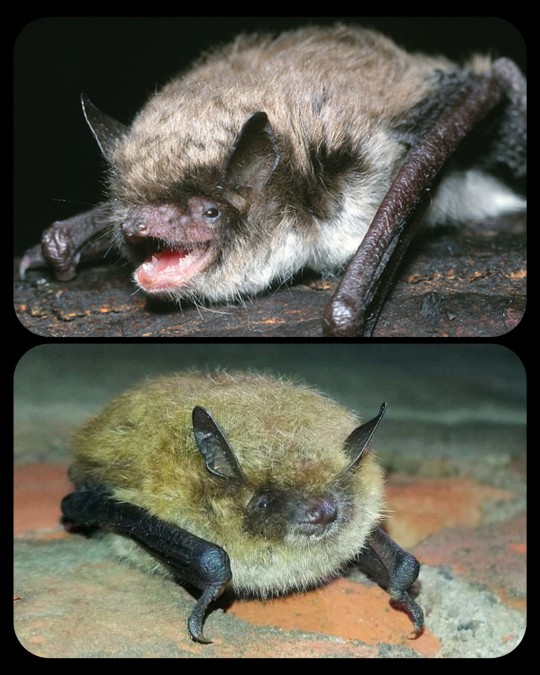
There are twelve other species within the genus Myotis that have been documented living past the age of 20, but the lifespan of the Brandt's bat is exceptionally long, especially compared to other small mammals.
This species (and the longevity of a few other bat species) defies our conventional understanding of the relationship between an animal's size and its lifespan -- smaller animals normally have a much shorter lifespan compared to large animals, partly due to their higher metabolic demands, but these bats represent a rare exception to that rule. In fact, with an average weight of just 4 to 8 grams (which is roughly the combined weight of 2 or 3 pennies), the Brandt's bat has the longest lifespan of any mammal relative to its size.
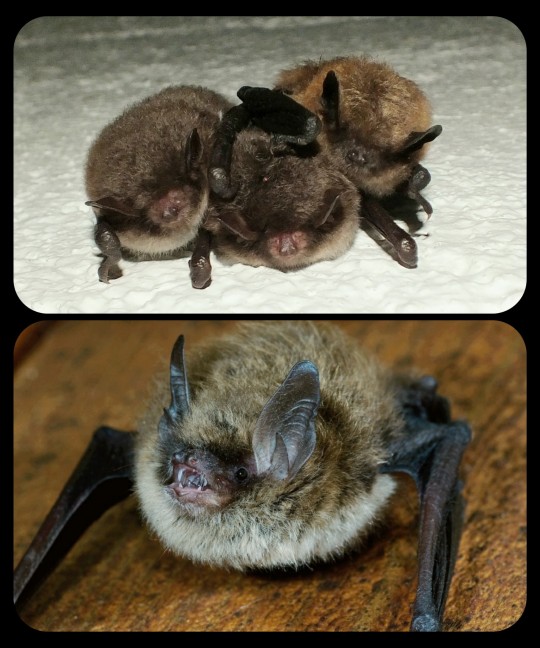
Research suggests that its increased lifespan may be at least partially linked to a mutation in two of the genes that are related to growth. This article describes the results of one particular study:
Genes for two proteins involved in growth — called growth hormone receptor (GHR) and insulinlike growth factor 1 receptor (IGF1R) — showed changes that also appear among other long-lived bat species. Previous studies in mice and other animals suggest genetic changes in GHR and IGF1R are linked with longevity. For instance, mice with mutations in GHR live twice as long as normal mice, said study researcher Vadim Gladyshev, a geneticist at Brigham and Women's Hospital in Boston.
These same genetic changes also may be responsible for the bats' small size ...
"We think the bat's life span is, in part, an unintended consequence of its small body size."
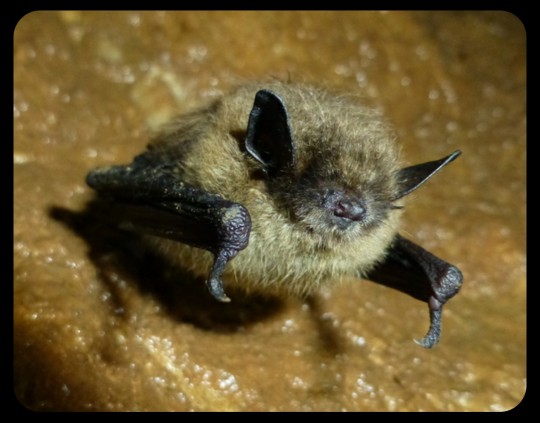
There are a few other factors that may also play a role:
Brandt's bats also hibernate and roost in caves — behaviors that may help them avoid predators and extreme weather conditions, and contribute to their longer life span, the researchers said. The Brandt's bat also takes a relatively long time to reach maturity, and it does not produce many offspring — two characteristics seen in larger, longer-living mammals.
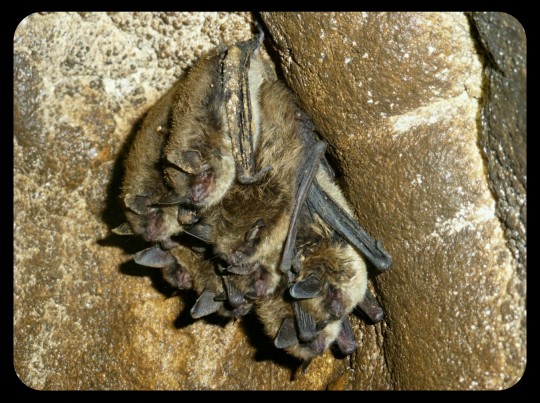
Note: nearly all of the articles that I came across refer to the 41-year-old bat as a "Brandt's bat," but at least one other source uses the term "Siberian whiskered myotis," instead. That term simply refers to the Siberian variety of the Brandt's bat (subspecies Myotis brandtii sibiricus) in particular.
Sources & More Info:
The Journals of Gerontology: A New Field Record for Bat Longevity
Bat Conservation International: Myotis brandtii
Nature: Genome Analysis Reveals Insights into Physiology and Longevity of the Brandt's Bat, Myotis brandtii
Nature: DNA Methylation Predicts Age and Provides Insight Into Exceptional Longevity of Bats
New Scientist: Gene Clues May Explain Why Brandt's Bat Lives So Long
#mammals#myotis brandtii#myotis brandtii sibiricus#siberian whiskered myotis#brandt's bat#siberia#bats#animals#longevity#world record#animal facts#nature#that bat is older than I am#and it looks like it has seen some shit#hang in there little buddy#(literally)
117 notes
·
View notes